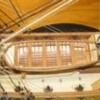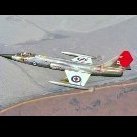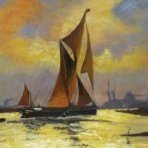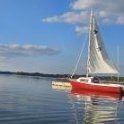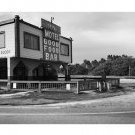MORE HANDBOOKS ARE ON THEIR WAY! We will let you know when they get here.
×
-
Posts
382 -
Joined
-
Last visited
Reputation Activity
-
 davec got a reaction from yvesvidal in AMC DH9 by davec - FINISHED - Wingnut Wings - 1/32
davec got a reaction from yvesvidal in AMC DH9 by davec - FINISHED - Wingnut Wings - 1/32
Ken - many thanks! That will save me a step and decrease the chance that I have another painting mishap.
Sprayed a lot of red paint today. The wings are drying. I went back to the fuselage, pulled off the rest of the masking, put a wash on the leather around the cockpit, and did more touching up. I also finished painting the tail. The stabilizer doesn't lie flat, so some of that area may end up visible. I'm very pleased with the instrument panel touch up. I didn't take a before picture, but the overspray was pretty significant. This is a vast improvement and I think this is the best I'm going to do - it isn't that easy to reach with a brush. I'll touch up the red on the edge (didn't see that until the picture). The red tinge on the middle upper instrument is probably reflection. It wasn't there when I went back to the model.
-
 davec got a reaction from yvesvidal in AMC DH9 by davec - FINISHED - Wingnut Wings - 1/32
davec got a reaction from yvesvidal in AMC DH9 by davec - FINISHED - Wingnut Wings - 1/32
I’ve been working on the model for a few minutes every few days. I got the fuselage closed. Tolerances are always so tight that despite being really careful to clean up the glue joints, I end up with a little step at the joint that requires some sanding and filling. I had a few mistakes when priming and sanding, especially not masking far enough away from where I was working and getting some overspray on the instrument panel, which was very frustrating. I always find masking world war 1 models with the exposed engines and open cockpits really challenging - please let me know if you have any suggestions. I’m painting the model red, so used white primer.
I just sprayed the red paint, which went down pretty well. The lobster scheme has decals over nearly the entire fuselage, so I sprayed gloss paint, which should let me put the decals on directly (do I need a clear gloss coat over a gloss finish?).
It looks pretty toylike now, but with the decals on and a clear flat coat, should look as intended. I’ve cleaned up the overspray and touched up, and am feeling better about the progress. I’ve always had difficulty getting a good finish brushing Tamiya paint and had my first revelation of the project – I highly recommend Tamiya retarder. Mixing a drop of retarder with a few drops of paint in a palette completely changes how it brushes – all of a sudden it flows really well. I’ve got a lot of the rest of the parts cut out and sanded and most painted. I masked and primed the wings this morning.
-
 davec got a reaction from Haliburton in AMC DH9 by davec - FINISHED - Wingnut Wings - 1/32
davec got a reaction from Haliburton in AMC DH9 by davec - FINISHED - Wingnut Wings - 1/32
Engine finished and the rest of the cockpit and engine compartment complete. Dry fit of the fuselage halves looks good. I spent a few hours cutting most of the rest of the parts off the sprues and cleaning them up, drilling holes for wire reinforcements for aileron and stabilizer attachments, and drilling holes for the rigging attachments. I didn't take pictures - just looks like a pile of parts.
-
 davec got a reaction from DocRob in AMC DH9 by davec - FINISHED - Wingnut Wings - 1/32
davec got a reaction from DocRob in AMC DH9 by davec - FINISHED - Wingnut Wings - 1/32
I’ve been working on the model for a few minutes every few days. I got the fuselage closed. Tolerances are always so tight that despite being really careful to clean up the glue joints, I end up with a little step at the joint that requires some sanding and filling. I had a few mistakes when priming and sanding, especially not masking far enough away from where I was working and getting some overspray on the instrument panel, which was very frustrating. I always find masking world war 1 models with the exposed engines and open cockpits really challenging - please let me know if you have any suggestions. I’m painting the model red, so used white primer.
I just sprayed the red paint, which went down pretty well. The lobster scheme has decals over nearly the entire fuselage, so I sprayed gloss paint, which should let me put the decals on directly (do I need a clear gloss coat over a gloss finish?).
It looks pretty toylike now, but with the decals on and a clear flat coat, should look as intended. I’ve cleaned up the overspray and touched up, and am feeling better about the progress. I’ve always had difficulty getting a good finish brushing Tamiya paint and had my first revelation of the project – I highly recommend Tamiya retarder. Mixing a drop of retarder with a few drops of paint in a palette completely changes how it brushes – all of a sudden it flows really well. I’ve got a lot of the rest of the parts cut out and sanded and most painted. I masked and primed the wings this morning.
-
 davec got a reaction from Landlubber Mike in AMC DH9 by davec - FINISHED - Wingnut Wings - 1/32
davec got a reaction from Landlubber Mike in AMC DH9 by davec - FINISHED - Wingnut Wings - 1/32
I’ve been working on the model for a few minutes every few days. I got the fuselage closed. Tolerances are always so tight that despite being really careful to clean up the glue joints, I end up with a little step at the joint that requires some sanding and filling. I had a few mistakes when priming and sanding, especially not masking far enough away from where I was working and getting some overspray on the instrument panel, which was very frustrating. I always find masking world war 1 models with the exposed engines and open cockpits really challenging - please let me know if you have any suggestions. I’m painting the model red, so used white primer.
I just sprayed the red paint, which went down pretty well. The lobster scheme has decals over nearly the entire fuselage, so I sprayed gloss paint, which should let me put the decals on directly (do I need a clear gloss coat over a gloss finish?).
It looks pretty toylike now, but with the decals on and a clear flat coat, should look as intended. I’ve cleaned up the overspray and touched up, and am feeling better about the progress. I’ve always had difficulty getting a good finish brushing Tamiya paint and had my first revelation of the project – I highly recommend Tamiya retarder. Mixing a drop of retarder with a few drops of paint in a palette completely changes how it brushes – all of a sudden it flows really well. I’ve got a lot of the rest of the parts cut out and sanded and most painted. I masked and primed the wings this morning.
-
 davec got a reaction from realworkingsailor in AMC DH9 by davec - FINISHED - Wingnut Wings - 1/32
davec got a reaction from realworkingsailor in AMC DH9 by davec - FINISHED - Wingnut Wings - 1/32
I’ve been working on the model for a few minutes every few days. I got the fuselage closed. Tolerances are always so tight that despite being really careful to clean up the glue joints, I end up with a little step at the joint that requires some sanding and filling. I had a few mistakes when priming and sanding, especially not masking far enough away from where I was working and getting some overspray on the instrument panel, which was very frustrating. I always find masking world war 1 models with the exposed engines and open cockpits really challenging - please let me know if you have any suggestions. I’m painting the model red, so used white primer.
I just sprayed the red paint, which went down pretty well. The lobster scheme has decals over nearly the entire fuselage, so I sprayed gloss paint, which should let me put the decals on directly (do I need a clear gloss coat over a gloss finish?).
It looks pretty toylike now, but with the decals on and a clear flat coat, should look as intended. I’ve cleaned up the overspray and touched up, and am feeling better about the progress. I’ve always had difficulty getting a good finish brushing Tamiya paint and had my first revelation of the project – I highly recommend Tamiya retarder. Mixing a drop of retarder with a few drops of paint in a palette completely changes how it brushes – all of a sudden it flows really well. I’ve got a lot of the rest of the parts cut out and sanded and most painted. I masked and primed the wings this morning.
-
 davec reacted to Baker in Mary Rose by Baker - scale 1/50 - "Your Noblest Shippe"
davec reacted to Baker in Mary Rose by Baker - scale 1/50 - "Your Noblest Shippe"
First. The schrouds problem
Fortunately, cherry wood is very flexible and this can be easily solved. By stretching the frames towards each other.
This is something for later, if I do this now I won't have enough space to work in the rear castle.
Continued with determining the position of the decks.
And the "gun wale". On this beam were the swivel guns placed on the first version of the Mary Rose, on the current version only 3 would have remained.
Memory aid. Where is what
Adjustment of the stern
The position of the 3 swivel guns
further surgery of the stern
Upper deck and castle deck determined. Upper castle still to do
current status
Thaks for following
-
 davec reacted to native one in La Mahonesa 1789 by native one - scale 1/48
davec reacted to native one in La Mahonesa 1789 by native one - scale 1/48
Finally finished planking the interior of the hull,then proceeded to the stern to began building the bulwark that separates the gunner room from the rest of the officers quarters, then realized I need the deck beams temporarily in so I can build the walls of the rooms up to and around the beams.
-
 davec reacted to native one in La Mahonesa 1789 by native one - scale 1/48
davec reacted to native one in La Mahonesa 1789 by native one - scale 1/48
With the deck down in the hold done,I can began building the storage rooms,towards midship the beams are two piece which are milled out then fine tuned with files,not very complicated work to be done but i ⁹really have to pay attention to where parts of the deck beams cut thru the walls in places.
-
 davec got a reaction from Mike Collier in East Coast Oyster Sharpie 1880-1900 by davec - FINISHED - 1/16 scale
davec got a reaction from Mike Collier in East Coast Oyster Sharpie 1880-1900 by davec - FINISHED - 1/16 scale
No log entries in two years, but I have been slowly plugging away a few minutes a week. I had a pretty steep learning curve silver soldering the brass fittings for the masts and figuring out how to make the mast hoops. Rope was made with Chuck Passaro’s rope rocket. Rigging relies heavily on John Leather's The Gaff Rig Handbook. When the book didn't have the necessary detail, I defaulted to the advice from the Mystic Seaport staff restoring their Sharpie - "These boats were built in people's backyards with what they could make or get from their local hardware store." I did not want to make sails and there is no rigging exerting downward pressure on the gaff, so rather than having limp rigging, I lowered the gaff as if a mainsail was about to be attached. Both kids were with their partner’s families this Christmas, so I got to spend some concentrated workshop time and finished this morning.
Next project is a case – I got some good tools for Christmas (router table, acrylic cutting table saw blade) so I should be able to build one. I made some acrylic shelves for my display case, so I’ve got the cutting and edge polishing down, and just need to sort out the gluing.
Happy New Year Everyone!
-
 davec got a reaction from KARAVOKIRIS in 18th Century Longboat 1750-1760 by davec - Model Shipways - 1/48
davec got a reaction from KARAVOKIRIS in 18th Century Longboat 1750-1760 by davec - Model Shipways - 1/48
I usually use minwax wipe on poly on boxwood and planned to do the same here. I thought applying it before assembly would work better than trying to brush or rub it on smoothly between the frames. I wanted to avoid the surfaces that would get glued. I usually use it full strength and apply as per the directions. This time I thinned with mineral spirits and brushed it on and am happy - I was able to brush around the slots for the frames and the pseudo-rabbet, so it shouldn't interfere with the strength of the glue joints. Only surprise was when I brushed over the laser precut separation, I got some laser char mixed in. Next time I'll need to try to vacuum or brush away any loose char from the slots before finishing. I've glued in the first frame.
-
 davec got a reaction from CiscoH in 18th Century Longboat 1750-1760 by davec - Model Shipways - 1/48
davec got a reaction from CiscoH in 18th Century Longboat 1750-1760 by davec - Model Shipways - 1/48
In addition to my DH-9, I’ve also started the Model Shipways longboat. There are lots of other build logs with pictures of the kit parts, so I won’t repeat pictures here. I'm very appreciative of all the other great logs to use for reference. This build will be very heavily kit-bashed. I’m planning on replacing all of the basswood with boxwood.
I’m very grateful to Chuck, who laser cut the frames for me. I was going to try to cut them on a scroll saw, but was worried that it wouldn't work as well as the laser for the partially cut inside each frame, which is important to hold everything together while fairing and planking.
Chuck not only sent me laser cut frames, but also the other laser cut pieces. The kit includes 3/32 thick basswood frames, which are a little out of scale, but necessary as the basswood isn’t as forgiving as boxwood for fairing and clamping the planks. Chuck cut the frames on 1/16” boxwood, which is more to scale. I thought I would have to scratch the false keel with 1/16 instead of 3/32 slots, but even that had been adjusted for – tremendously impressive.
I usually scratch build, so this was my first experience with laser cutting and removing char. The thread on char removal (char-removal-arrrghh) was really helpful. Scraping with an 11 blade followed by 320 grit sandpaper has worked pretty well for me. I’ve been using an abrasive cleaning stick so I don’t have to discard the sanding stick once it gets dirty with char, which has also worked pretty well. It is also taking some time to get used to adjusting the laser kerf to a right angle. Removing char and kerf without changing the part's size and shape has been a challenge. I thought I had screwed up taking too much off the stem when I saw it didn't line up with the keel. I saw Chuck’s comment in the other thread that he makes the parts oversize to allow for cleanup and checked the plans. The stem is the right size and I just need to sand down the keel to match.
I’m having mixed feelings about laser cutting. It is great for complicated parts like the frames and the keelson with all the slots. I just made the filler pieces for the bow. It was much faster to cut them on the scroll saw than it would have been to clean the char. I’ll probably be selective about which laser cut pieces I use and which ones I replace moving forward.
Keel and keelson are done and glued. I think I have the tapering right for the rabbet, and after a little filing, the frames all fit in the slots in the keelson. I'll start assembling the frames soon.
-
 davec got a reaction from GrandpaPhil in AMC DH9 by davec - FINISHED - Wingnut Wings - 1/32
davec got a reaction from GrandpaPhil in AMC DH9 by davec - FINISHED - Wingnut Wings - 1/32
I’ve been working on the model for a few minutes every few days. I got the fuselage closed. Tolerances are always so tight that despite being really careful to clean up the glue joints, I end up with a little step at the joint that requires some sanding and filling. I had a few mistakes when priming and sanding, especially not masking far enough away from where I was working and getting some overspray on the instrument panel, which was very frustrating. I always find masking world war 1 models with the exposed engines and open cockpits really challenging - please let me know if you have any suggestions. I’m painting the model red, so used white primer.
I just sprayed the red paint, which went down pretty well. The lobster scheme has decals over nearly the entire fuselage, so I sprayed gloss paint, which should let me put the decals on directly (do I need a clear gloss coat over a gloss finish?).
It looks pretty toylike now, but with the decals on and a clear flat coat, should look as intended. I’ve cleaned up the overspray and touched up, and am feeling better about the progress. I’ve always had difficulty getting a good finish brushing Tamiya paint and had my first revelation of the project – I highly recommend Tamiya retarder. Mixing a drop of retarder with a few drops of paint in a palette completely changes how it brushes – all of a sudden it flows really well. I’ve got a lot of the rest of the parts cut out and sanded and most painted. I masked and primed the wings this morning.
-
 davec got a reaction from AJohnson in 18th Century Longboat 1750-1760 by davec - Model Shipways - 1/48
davec got a reaction from AJohnson in 18th Century Longboat 1750-1760 by davec - Model Shipways - 1/48
Getting the frames set in all 3 dimensions turned a little more challenging than I thought. I’ve done some travelling and only had short workshop sessions each day, so was only attaching 1-2 frames every few days.
I had a setback where every time I added a piece, I got a dark mark at the joint. I thought it was the char particles getting caught in the glue so I debonded, sanded, and reglued a few times. I finally realized that the moisture in the glue was oxidizing the machinist angle plates I was using to keep things square when drying. I stopped using the plates, which got rid of the staining, but made keeping everything oriented more challenging. I think I finally have the frames where I want them.
I’ll be shaping a sacrificial strip to glue across the upper end of the frames, crossing over to the filler pieces. I’m worried that I debonded and reglued so much that my glue joints won’t be strong and the extra support will be important. I have the last piece drying and will post a picture later today.
-
 davec got a reaction from Ryland Craze in Grand Banks Dory by davec - FINISHED - Model Shipways - 1:24 - Shipwright Series
davec got a reaction from Ryland Craze in Grand Banks Dory by davec - FINISHED - Model Shipways - 1:24 - Shipwright Series
Robert - many thanks! I have a special talent for turning simple things into challenges.
Helge - thanks for following. I looked at your build, which looks really interesting. I hadn't realized that Dorys were rigged for sail. I plan on building according to the model shipways plans (or at least to scans of the kit parts) so will not be rigging the model.
I've made a little progress, adding the stem and stern. I've started cutting the frames and crosspieces for the building jig.
-
 davec got a reaction from MBerg in Grand Banks Dory by davec - FINISHED - Model Shipways - 1:24 - Shipwright Series
davec got a reaction from MBerg in Grand Banks Dory by davec - FINISHED - Model Shipways - 1:24 - Shipwright Series
I started another project, the Model Shipways Grand Banks Dory. There are many build logs with kit pictures, so I won’t include here. I’m planning on replacing all the basswood anyways.
I usually have two projects (wooden ship and plastic airplane) going, but for a bunch of reasons, thought I should try doing two ship models at the same time.
Rationale:
· I got a really good deal on it at a club auction
· I’ve wanted to try one of David Antscherl’s kits
· I think I have my jointer and bandsaw finally tuned right, and wanted to try milling some wood
· I’ve found working with laser cut pieces on the longboat a little frustrating. I’m sure I will get better at it with some more practice, but wanted to get a sense of the comparison between cutting the parts out myself vs cleaning char off laser cut pieces.
· I want to build with boxwood and some contrasting wood, and wanted to see how well patterns made from scanned laser cut sheets would work. This was particularly important on this model as the plans in the instruction book don’t include all the parts.
· Main reason: I’m planning on starting a fully framed Echo, but want another project going so I don’t try working on Echo when tired or distracted. This seemed a good opportunity to pilot building two ship models at the same time. If it isn’t going to work for two fairly simple kits (longboat and Dory), I shouldn’t try it with Echo.
So far, so good. I started with the stand as a test for the jointer and bandsaw. The wood is a piece of pao ferro that I had on my shelf. Very happy with both tools. The bandsaw got knocked out of alignment during the house move a few years ago, and is finally dialed back in. The jointer was never fully adjusted and is finally working the way it should.
Scanning the basswood laser cut sheets has also worked well. The burn marks are thin enough and in the right place to get good patterns. For the first few pieces (hull bottom, stem, transom, stern knee) cutting the parts out has been very straightforward and taken less time than cleaning char. For some parts like the longboat frames this would not be true.
I’ve also been making some progress on the other two projects and will update the logs soon.
-
 davec got a reaction from MBerg in Grand Banks Dory by davec - FINISHED - Model Shipways - 1:24 - Shipwright Series
davec got a reaction from MBerg in Grand Banks Dory by davec - FINISHED - Model Shipways - 1:24 - Shipwright Series
Robert - many thanks! I have a special talent for turning simple things into challenges.
Helge - thanks for following. I looked at your build, which looks really interesting. I hadn't realized that Dorys were rigged for sail. I plan on building according to the model shipways plans (or at least to scans of the kit parts) so will not be rigging the model.
I've made a little progress, adding the stem and stern. I've started cutting the frames and crosspieces for the building jig.
-
 davec got a reaction from SiriusVoyager in Grand Banks Dory by davec - FINISHED - Model Shipways - 1:24 - Shipwright Series
davec got a reaction from SiriusVoyager in Grand Banks Dory by davec - FINISHED - Model Shipways - 1:24 - Shipwright Series
I started another project, the Model Shipways Grand Banks Dory. There are many build logs with kit pictures, so I won’t include here. I’m planning on replacing all the basswood anyways.
I usually have two projects (wooden ship and plastic airplane) going, but for a bunch of reasons, thought I should try doing two ship models at the same time.
Rationale:
· I got a really good deal on it at a club auction
· I’ve wanted to try one of David Antscherl’s kits
· I think I have my jointer and bandsaw finally tuned right, and wanted to try milling some wood
· I’ve found working with laser cut pieces on the longboat a little frustrating. I’m sure I will get better at it with some more practice, but wanted to get a sense of the comparison between cutting the parts out myself vs cleaning char off laser cut pieces.
· I want to build with boxwood and some contrasting wood, and wanted to see how well patterns made from scanned laser cut sheets would work. This was particularly important on this model as the plans in the instruction book don’t include all the parts.
· Main reason: I’m planning on starting a fully framed Echo, but want another project going so I don’t try working on Echo when tired or distracted. This seemed a good opportunity to pilot building two ship models at the same time. If it isn’t going to work for two fairly simple kits (longboat and Dory), I shouldn’t try it with Echo.
So far, so good. I started with the stand as a test for the jointer and bandsaw. The wood is a piece of pao ferro that I had on my shelf. Very happy with both tools. The bandsaw got knocked out of alignment during the house move a few years ago, and is finally dialed back in. The jointer was never fully adjusted and is finally working the way it should.
Scanning the basswood laser cut sheets has also worked well. The burn marks are thin enough and in the right place to get good patterns. For the first few pieces (hull bottom, stem, transom, stern knee) cutting the parts out has been very straightforward and taken less time than cleaning char. For some parts like the longboat frames this would not be true.
I’ve also been making some progress on the other two projects and will update the logs soon.
-
 davec got a reaction from druxey in Grand Banks Dory by davec - FINISHED - Model Shipways - 1:24 - Shipwright Series
davec got a reaction from druxey in Grand Banks Dory by davec - FINISHED - Model Shipways - 1:24 - Shipwright Series
Robert - many thanks! I have a special talent for turning simple things into challenges.
Helge - thanks for following. I looked at your build, which looks really interesting. I hadn't realized that Dorys were rigged for sail. I plan on building according to the model shipways plans (or at least to scans of the kit parts) so will not be rigging the model.
I've made a little progress, adding the stem and stern. I've started cutting the frames and crosspieces for the building jig.
-
 davec got a reaction from VTHokiEE in Grand Banks Dory by davec - FINISHED - Model Shipways - 1:24 - Shipwright Series
davec got a reaction from VTHokiEE in Grand Banks Dory by davec - FINISHED - Model Shipways - 1:24 - Shipwright Series
Robert - many thanks! I have a special talent for turning simple things into challenges.
Helge - thanks for following. I looked at your build, which looks really interesting. I hadn't realized that Dorys were rigged for sail. I plan on building according to the model shipways plans (or at least to scans of the kit parts) so will not be rigging the model.
I've made a little progress, adding the stem and stern. I've started cutting the frames and crosspieces for the building jig.
-
 davec got a reaction from Haliburton in AMC DH9 by davec - FINISHED - Wingnut Wings - 1/32
davec got a reaction from Haliburton in AMC DH9 by davec - FINISHED - Wingnut Wings - 1/32
I’ve been working on the model for a few minutes every few days. I got the fuselage closed. Tolerances are always so tight that despite being really careful to clean up the glue joints, I end up with a little step at the joint that requires some sanding and filling. I had a few mistakes when priming and sanding, especially not masking far enough away from where I was working and getting some overspray on the instrument panel, which was very frustrating. I always find masking world war 1 models with the exposed engines and open cockpits really challenging - please let me know if you have any suggestions. I’m painting the model red, so used white primer.
I just sprayed the red paint, which went down pretty well. The lobster scheme has decals over nearly the entire fuselage, so I sprayed gloss paint, which should let me put the decals on directly (do I need a clear gloss coat over a gloss finish?).
It looks pretty toylike now, but with the decals on and a clear flat coat, should look as intended. I’ve cleaned up the overspray and touched up, and am feeling better about the progress. I’ve always had difficulty getting a good finish brushing Tamiya paint and had my first revelation of the project – I highly recommend Tamiya retarder. Mixing a drop of retarder with a few drops of paint in a palette completely changes how it brushes – all of a sudden it flows really well. I’ve got a lot of the rest of the parts cut out and sanded and most painted. I masked and primed the wings this morning.
-
 davec got a reaction from mtaylor in AMC DH9 by davec - FINISHED - Wingnut Wings - 1/32
davec got a reaction from mtaylor in AMC DH9 by davec - FINISHED - Wingnut Wings - 1/32
I’ve been working on the model for a few minutes every few days. I got the fuselage closed. Tolerances are always so tight that despite being really careful to clean up the glue joints, I end up with a little step at the joint that requires some sanding and filling. I had a few mistakes when priming and sanding, especially not masking far enough away from where I was working and getting some overspray on the instrument panel, which was very frustrating. I always find masking world war 1 models with the exposed engines and open cockpits really challenging - please let me know if you have any suggestions. I’m painting the model red, so used white primer.
I just sprayed the red paint, which went down pretty well. The lobster scheme has decals over nearly the entire fuselage, so I sprayed gloss paint, which should let me put the decals on directly (do I need a clear gloss coat over a gloss finish?).
It looks pretty toylike now, but with the decals on and a clear flat coat, should look as intended. I’ve cleaned up the overspray and touched up, and am feeling better about the progress. I’ve always had difficulty getting a good finish brushing Tamiya paint and had my first revelation of the project – I highly recommend Tamiya retarder. Mixing a drop of retarder with a few drops of paint in a palette completely changes how it brushes – all of a sudden it flows really well. I’ve got a lot of the rest of the parts cut out and sanded and most painted. I masked and primed the wings this morning.
-
 davec got a reaction from AJohnson in AMC DH9 by davec - FINISHED - Wingnut Wings - 1/32
davec got a reaction from AJohnson in AMC DH9 by davec - FINISHED - Wingnut Wings - 1/32
I’ve been working on the model for a few minutes every few days. I got the fuselage closed. Tolerances are always so tight that despite being really careful to clean up the glue joints, I end up with a little step at the joint that requires some sanding and filling. I had a few mistakes when priming and sanding, especially not masking far enough away from where I was working and getting some overspray on the instrument panel, which was very frustrating. I always find masking world war 1 models with the exposed engines and open cockpits really challenging - please let me know if you have any suggestions. I’m painting the model red, so used white primer.
I just sprayed the red paint, which went down pretty well. The lobster scheme has decals over nearly the entire fuselage, so I sprayed gloss paint, which should let me put the decals on directly (do I need a clear gloss coat over a gloss finish?).
It looks pretty toylike now, but with the decals on and a clear flat coat, should look as intended. I’ve cleaned up the overspray and touched up, and am feeling better about the progress. I’ve always had difficulty getting a good finish brushing Tamiya paint and had my first revelation of the project – I highly recommend Tamiya retarder. Mixing a drop of retarder with a few drops of paint in a palette completely changes how it brushes – all of a sudden it flows really well. I’ve got a lot of the rest of the parts cut out and sanded and most painted. I masked and primed the wings this morning.
-
 davec got a reaction from robert952 in Grand Banks Dory by davec - FINISHED - Model Shipways - 1:24 - Shipwright Series
davec got a reaction from robert952 in Grand Banks Dory by davec - FINISHED - Model Shipways - 1:24 - Shipwright Series
Robert - many thanks! I have a special talent for turning simple things into challenges.
Helge - thanks for following. I looked at your build, which looks really interesting. I hadn't realized that Dorys were rigged for sail. I plan on building according to the model shipways plans (or at least to scans of the kit parts) so will not be rigging the model.
I've made a little progress, adding the stem and stern. I've started cutting the frames and crosspieces for the building jig.
-
 davec got a reaction from Harvey Golden in Grand Banks Dory by davec - FINISHED - Model Shipways - 1:24 - Shipwright Series
davec got a reaction from Harvey Golden in Grand Banks Dory by davec - FINISHED - Model Shipways - 1:24 - Shipwright Series
I started another project, the Model Shipways Grand Banks Dory. There are many build logs with kit pictures, so I won’t include here. I’m planning on replacing all the basswood anyways.
I usually have two projects (wooden ship and plastic airplane) going, but for a bunch of reasons, thought I should try doing two ship models at the same time.
Rationale:
· I got a really good deal on it at a club auction
· I’ve wanted to try one of David Antscherl’s kits
· I think I have my jointer and bandsaw finally tuned right, and wanted to try milling some wood
· I’ve found working with laser cut pieces on the longboat a little frustrating. I’m sure I will get better at it with some more practice, but wanted to get a sense of the comparison between cutting the parts out myself vs cleaning char off laser cut pieces.
· I want to build with boxwood and some contrasting wood, and wanted to see how well patterns made from scanned laser cut sheets would work. This was particularly important on this model as the plans in the instruction book don’t include all the parts.
· Main reason: I’m planning on starting a fully framed Echo, but want another project going so I don’t try working on Echo when tired or distracted. This seemed a good opportunity to pilot building two ship models at the same time. If it isn’t going to work for two fairly simple kits (longboat and Dory), I shouldn’t try it with Echo.
So far, so good. I started with the stand as a test for the jointer and bandsaw. The wood is a piece of pao ferro that I had on my shelf. Very happy with both tools. The bandsaw got knocked out of alignment during the house move a few years ago, and is finally dialed back in. The jointer was never fully adjusted and is finally working the way it should.
Scanning the basswood laser cut sheets has also worked well. The burn marks are thin enough and in the right place to get good patterns. For the first few pieces (hull bottom, stem, transom, stern knee) cutting the parts out has been very straightforward and taken less time than cleaning char. For some parts like the longboat frames this would not be true.
I’ve also been making some progress on the other two projects and will update the logs soon.


